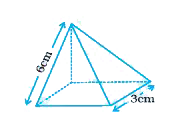In a polyhedron, if the number of faces, edges and vertices are denoted by F,E and V respectively, then according to Euler's formula
F+V-E=2
F-V+E=2
F-V-E=2
F+V=E-2
The correct Answer is:A
To solve the question regarding Euler's formula for polyhedra, we will follow these steps:
1. Understanding the Variables:
- Let F represent the number of faces of the polyhedron.
- Let V represent the number of vertices of the polyhedron.
- Let E represent the number of edges of the polyhedron.
2. State Euler's Formula:
- Euler's formula for polyhedra states that:
F+V−E=2
- This can also be rearranged to:
F+V=E+2
3. Rearranging the Formula:
- If we want to express the relationship in another way, we can rearrange it to:
F+V−E=2
4. Conclusion:
- This formula is fundamental in the study of polyhedra and helps in understanding the relationship between the faces, vertices, and edges of a polyhedron.
- Let F represent the number of faces of the polyhedron.
- Let V represent the number of vertices of the polyhedron.
- Let E represent the number of edges of the polyhedron.
- Euler's formula for polyhedra states that:
F+V−E=2
- This can also be rearranged to:
F+V=E+2
- If we want to express the relationship in another way, we can rearrange it to:
F+V−E=2
- This formula is fundamental in the study of polyhedra and helps in understanding the relationship between the faces, vertices, and edges of a polyhedron.
Similar Questions
Knowledge Check
Can a polyhedron have 10 faces, 20 edges and 15 vertices? Check using Euler's formula.
AYesBNoCCannot be determinedDNone of the aboveThe number of vertices, edges and faces respectively of a cuboid are
A8, 6, 12B12, 8, 6C8, 12, 6D12, 6,8The number of faces and edges a tetrahedron respectively has
A6, 6B4, 6C4, 4D5, 5
In a regular polyhedron ______ number of faces meet at each vertex.
View SolutionHow many faces, edges and vertices does the solid have?

View SolutionHow many faces, edges and vertices does the solid have?

View SolutionHow many faces, edges and vertices does the solid have?

View SolutionA polyhedron with 8 faces and 12 vertices has .......... edges.
View Solution
